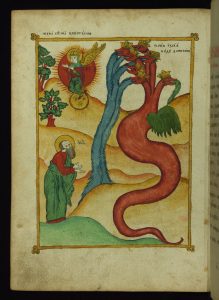Woodblock printing is one of the oldest printing techniques, used for text, images and patterns. This ancient technique originated in China, was adopted and handed down over centuries by Japanese artists.

Image source:
https://search.creativecommons.org/photos/55332312-e4d7-4cb1-824b-57876698cd3b by Free Public Domain Illustrations by rawpixel
The Technique
The woodblock is a printing method based on relief. Parts that are not to be printed, shown in white, are cut out. The block is pressed on the back of a paper, defining the image or the text. In the case of color printing, one block for each color is pressed on the raised parts and applied like a relief. While western tradition presses and applies the colors with a roller, Asians apply watercolors with a brush, then rub the block. Commonly were used woodblocks harvested from fruit-bearing trees like pear or cherry, or linden and poplar. Nowadays plywood is widely used.


Image source:
https://search.creativecommons.org/photos/f794e8c3-8bf0-41d3-a86a-78782c2ec6a8 by Arian Zwegers
: https://search.creativecommons.org/photos/6a99d15d-04e7-4f93-8fa4-ed6aa4e9e2ef
The Origin of Woodblock Print
This ancient printing technique was used in carved and formed stamps or seals. Anyway, printmaking would never have been possible without the discovery of paper in the early 2nd century AD, so wood printing cannot be dated before this period. The first Chinese woodblock print book ever found is the Diamant-Sutra from Dunhuang, printed in the 9th century AD; due to the advanced technique we can assume that woodblocks must have developed long before then. In general, woodcuts were used in ancient China primarily to spread Buddhist texts and amulets.

Discovered in 1990 in the Hongfo Pagoda at Helan County, Ningxia. Held at the Ningxia Museum, Yinchuan.
Image source:
https://commons.wikimedia.org/w/index.php?curid=51432885
Woodblocks in Europe
Woodblock printing arrived in Europe with the introduction of paper production in paper mills, during the Middle Age. The first woodblock prints were single-page prints, representing holy figures and religious subjects. They were usually stuck on the covers of books or pinned to walls, but sometimes prints were used to cover entire doors and ceilings. These early prints were made by hand with a muller, and hand-colored by the famous letter painters. Europe developed its own style in woodblock printing. Lines cuts were the most prevalent type of print. The woodblocks prints were inspired by the black lead drawing of colored Gothic glass windows. The next steps were to block books, pressed or rubbed onto pages. It was only possible to print on one side, so the blank sides were glued together in order to create a single page. Popular book themes were the poor’s Bible, the death dance, or books of planets.


A dragon and the woman clothed in the sun,
Walters Manuscript W.917, fol. 111v

Image source:
https://search.creativecommons.org/photos/8293451c-681b-4430-9784-217ac421c565 by Walters Art Museum Illuminated Manuscripts
: https://search.creativecommons.org/photos/b1429bdc-74b4-415b-89c6-1f2aa3bac041 by Walters Art Museum Illuminated Manuscripts
: https://search.creativecommons.org/photos/12b2286c-396c-40f7-80cc-44df7ef5955b by Dr. Alexey Yakovlev
A Master of Woodblocks Printing

Around the 16th century, the woodcut spread in Germany and Netherlands, especially for book illustrations. The “Schedel’s Weltchronik“, also known as “Nuremberg Chronicles” is an illustrated encyclopedia and one of the most famous works from this period. Woodcarving became the passion of some german artists, including Albrecht Dürer from Nuremberg, who was responsible for transforming this printing technique in art in Europe. Dürer’s large woodblocks became popular, especially “Apocalypse“, and brought fame to the author.
The Eastern Charm: Ukiyo-e Prints
Woodblocks were displaced around the 16th century when etching became the most used printing technique in all of Europe. They gradually disappeared, losing importance due to the invention of lithography first, and photography later. But in the mid-19th century, something unexpected happened: with the opening of Japan, ukiyo-e prints were brought to Europe, impressing avant-garde artists such as Vincent van Gogh. This technique revived in Europe thanks to the Expressionists.

Katsushika Hokusai, “Goten-Yama Hill, Shinagawa on the Tokaido”. This print is a perfect example of traditional Japanese Ukyio-e prints, representing the sakura blossom with Mount Fuji in the background.
Image source:
https://commons.wikimedia.org/wiki/File:Ukiyo-e_woodblock_print_by_Katsushika_Hokusai,_digitally_enhanced_by_rawpixel-com_15.jpg Author: Rawpixel
Info source:
https://en.wikipedia.org/wiki/Block_book
https://en.wikipedia.org/wiki/Nuremberg_Chronicle
https://www.britannica.com/art/woodcut
https://www.artelino.com/articles/woodblock-prints.asp
https://en.wikipedia.org/wiki/Woodblock_printing#Technique
